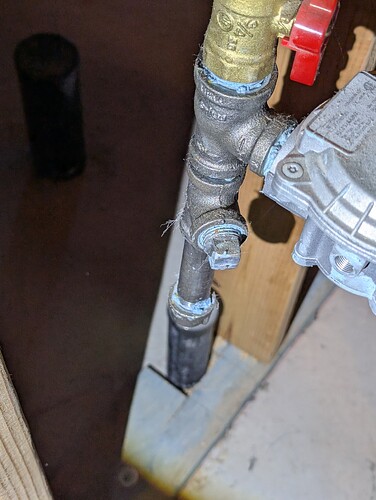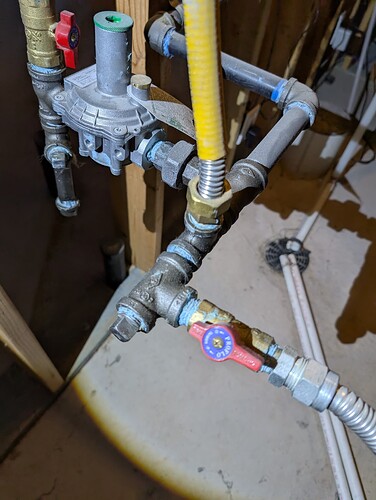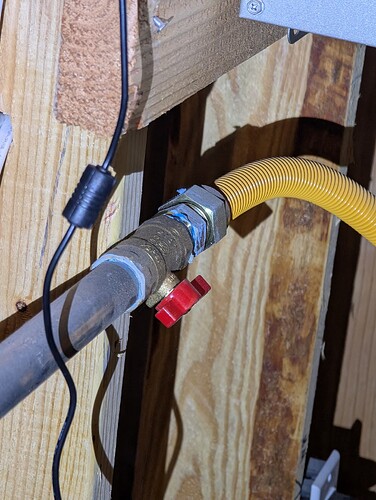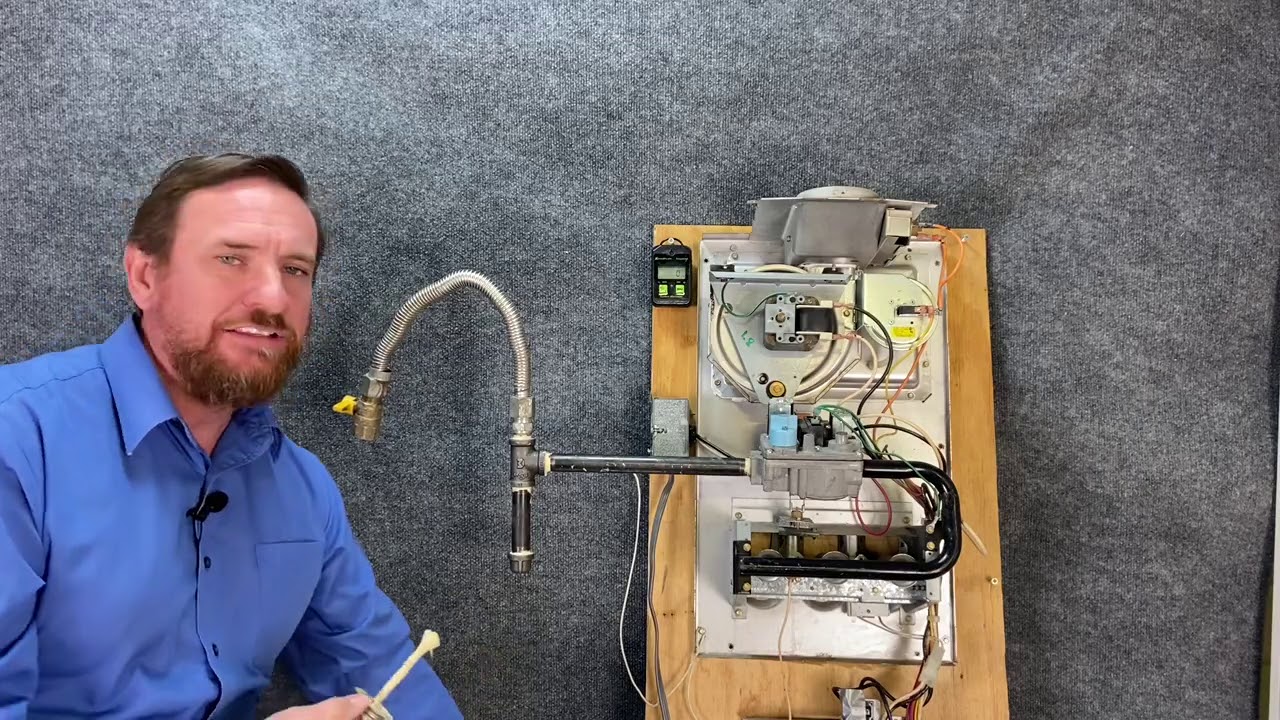Thoughts and maybe some clarification on my understanding of this.
This is how I understand it: each gas appliance should have its own gas leg/sediment drip. This has one on the main line, but the furnace and tankless water heater do not have one.
Would you write this up?
G2419.4 (408.4) Sediment trap.
Where a sediment trap is not incorporated as part of the appliance, a sediment trap shall be installed downstream of the appliance shutoff valve as close to the inlet of the appliance as practical. The sediment trap shall be either a tee fitting having a capped nipple of any length installed vertically in the bottommost opening of the tee as illustrated in Figure G2419.4 or other device approved as an effective sediment trap. Illuminating appliances, ranges, clothes dryers, decorative vented appliances for installation in vented fireplaces, gas fireplaces and outdoor grills need not be so equipped.
I would put it in the report as an installation defect. Maryland requires me to recommend the yellow CSST bonding be checked by a Master Electrician.
My personal opinion that the sediment trap before the regulator is all that is needed. I would most likely not say anything in my report. But, this is me and you might have a differeing opinion.![]()
I agree with Scott.
I agree as well. Not a problem as there is a drip leg installed.
The CSST is another issue.
Would you write this up?
There are install manuals that may require traps, ie. such as equipment installed on the exterior in cold weather weather zones primarily where condensation will occur from moisture in the gas exposed to temperatures below its dew point. This keeps the moisture out as well as sediment (rust) inside the pipe because of the condensation.
When you have a question like this, I recommend you refer to the Home Inspection Standards:
a. You do not interpret or enforce Codes. For one, you do not know what the code is. The code is, what the local AHJ has adopted through state and local action.
b. You do not have enforcement power to require a change. This just raises conflict that you created and when all the arguing is done, you can’t win what is not yours to win. Just makes you look bad.
1.1. A home inspection is a non-invasive, visual examination of the accessible areas of a residential property (as delineated below), performed for a fee, which is designed to identify defects within specific systems and components defined by these Standards that are both observed and deemed material by the inspector.
What did you observe that indicates to you visually, that this is not performing as intended?
Is the drip leg a cause of some apparent problem with the gas supply to the appliances?
I. The home inspection is based on the observations made on the date of the inspection, and not a prediction of future conditions.
Yes, some crap in the line may cause an issue in the future, but you don’t know that. Are you not claiming that even though the equipment is operating, it could possibility be a problem in the future?
You are not someone in the trades that are qualified to make this call. Are you not asking us here? Do you not recommend further evaluation by the expert you site in your report? So why are you wanting to just cause an argument over something you saw on This Old House when you were growing up?
1.2. A material defect is a specific issue with a system or component of a residential property that may have a significant, adverse impact on the value of the property, or that poses an unreasonable risk to people. The fact that a system or component is near, at, or beyond the end of its normal, useful life is not, in itself, a material defect.
Crap in the gas line does not pose a significant adverse condition that can’t be easily fixed. A Real Estate Appraiser is not going to devalue the property over a gas line trap. And it is not a risk to people.
If your reporting things like this, is it to make you look better than the Contractor, or the Building Code Inspector? Is it the need to have as much stuff in the report as possible to justify your existence? No one is looking for more problems to come up in the purchase and sale process than already exists. The SOP is written specifically for a certain level of inspection. Things that do not operate as intended is also in the Real Estate Contract and says through disclosure that , everything in the property listing is in proper operating condition, unless disclosed in the listing or disclosure statement. Are you trying to protect your liability for not cover everything a client might accuse you of? This is not how that works. When you step outside your SOP and you don’t win the fight, it just opens you up for more stuff you may have been wrong about.
If someone addresses the the sediment trap, that’s someone else’s job, not yours. It says it in the SOP. The client does not know what is in the SOP so you have to address this sometimes, but that will be a lot less frequent than creating issues on how someone build it. Find what they did wrong and report the adverse conditions occurring because of it.
If you see something that you feel is incorrect, can you identify the what might happen as is happening? If you can’t, you can’t write a narrative. Happens here all the time.
You can convey your opinion verbally all day long to help the client understand what they are purchasing. “If the furnace does not come on, it could be because a trap didn’t catch it”. But you don’t need the opinion of the rest of the world.
If they ask you to put something in the report, do it.
The scope of work may be modified by the Client and Inspector prior to the inspection process.
This is never going to be an issue. I wouldn’t bother reporting on it.
This is how I understand it: each gas appliance should have its own gas leg/sediment drip. This has one on the main line, but the furnace and tankless water heater do not have one.
Would you write this up?..
I think your understanding is correct for the most part. If you look up the manuals for the appliances, they will likely state that a drip leg/sediment trap be installed as close to the appliance as practical. In your opinion, is the one in your application installed as close to the appliance as possible? That said, it will likely never be an issue, until your client sells the home and the next inspector writes it up. ![]()
If you ever want to see how effective a sediment trap is with modern appliances, take one apart. Tell me what you find.
Sediment traps were designed and written into code when gas was filthy. It’s not like that today.
It’s there as a common sediment trap for all of the appliances. It’s the first thing that gets hit before gas is distributed to the appliances.
What a bizarre and unnecessarily long comment, it almost reads like there’s some unresolved frustration or a grudge against inspectors simply asking questions. This is an online forum. Its entire purpose is to allow home inspectors to ask questions and share insight. Your response doesn’t really make sense in that context.
As for whether this particular issue is valid, that’s a question better directed at the manufacturer or the local code inspector. They’re the ones who typically require sediment traps to be installed after the shutoff valve and as close to the appliance as possible.
As home inspectors, we don’t send out contractors, we document and report issues. In this case, we’re looking at something that violates both manufacturer installation guidelines and code in many areas. Regardless of personal opinions, those facts remain. I don’t exaggerate this issue, and when I speak to clients, I explain that gas is much cleaner than it used to be and this may not present an immediate hazard, or even an issue at all, especially if there is a trap located on the main line. However, since manufacturers still require sediment traps, and many codes have adopted those standards, I recommend the client consult a licensed HVAC or plumbing contractor for clarification.
We’re not code enforcers, but we are expected to understand code because it exists to protect people. I always try to follow the spirit of the code rather than get hung up on the exact letter. What was the intent of this requirement? That’s what I keep in mind during inspections.
For background: I’ve been a general contractor for 6 years and have more direct experience with building codes than many inspectors. I’ve also been a licensed Realtor for 16 years and have seen countless inspection reports. Some were well done, others unnecessarily alarmist, especially in places like Utah, where there are no licensing requirements for home inspectors. Unfortunately, I’ve seen inspectors with minimal construction knowledge call out minor or irrelevant items that only serve to confuse or scare clients.
That’s not my style. I don’t feel the need to nitpick or inflate my importance. I’ve seen inspectors (and professionals in other trades) do that just to seem more knowledgeable and important. City inspectors, in particular, were some of the worst offenders when I was a contractor they always had to find something. That’s not how I do inspections. I focus on education. I don’t kill deals; if a home falls through, it does so on its own merits. My job is to clearly report the facts in a way that clients can understand. That’s it.
Again, my original point here was simply to ask how others handle this in their markets. We all have something to learn from one another. The moment we think we know it all, or assume we know more than everyone else, is the moment we stop growing and progressing, both as professionals and personally.
What a bizarre and unnecessarily long comment, it almost reads like there’s some unresolved frustration or a grudge against inspectors
I’ve been a general contractor for 6 years
I’ve also been a licensed Realtor for 16 years
Well… that certainly explains YOUR issue with knowledgeable inspectors, and YOUR need for a “bizarre and unnecessarily long comment(s)”!!
I have an issue with unknowledgeable inspectors. There are plenty to go around, especially in a state that requires no licensing for them like the one I live in.
If you just want to argue for the sake of arguing, that is pointless. If you have any real feedback that would be great.
Again, my original point here was simply to ask how others handle this in their markets. We all have something to learn from one another.
I think you could have said that in about fifteen words or less!![]()
What a bizarre and unnecessarily long comment, it almost reads like there’s some unresolved frustration or a grudge against inspectors simply asking questions.
I wouldn’t worry about his response. He once wrote me a novel because he thought I used an adjective out of context. He is no longer a home inspector, he retired his license and gave up his certification because he feels that it’s beneath him. He’s your go to guy for HVAC and ventilation issues, but he mainly uses the InterNACHI SOP to condescend “screwdriver and flashlight” home inspectors to keep them in check.
I have an issue with unknowledgeable inspectors.
When I was in apprentice, I was told be quiet. Keep your mouth shut and your ears open.
I wouldn’t worry about his response. He once wrote me a novel because he thought I used an adjective out of context. He is no longer a home inspector, he retired his license and gave up his certification because he feels that it’s beneath him. He’s your go to guy for HVAC and ventilation issues, but he mainly uses the InterNACHI SOP to condescend “screwdriver and flashlight” home inspectors to keep them in check.
Thanks, I can now add you and a Glenn to the “Don’t waste you time with” list.
To set the record straight about your alleged acquisitions of my post, I write a lot when I am talking about concepts I am trying to relate, not to “what is the age of this 20yr old A/C unit?” type information requests. They get long because I don’t type them out, I have used voice recognition since it came out for writing my reports. I don’t use canned narratives.
I am a retired Home Inspector, 72yrs old. I retired my license when my Inspections were no longer just a Home Inspection. All my cases were and still are about fixing unsolved building problems, so I did not see the need to pay $2,300 in HI Insurance, and take Home Inspection 101 courses to maintain that license. At the time I was also dealing with kidney failure. Dialysis at home and eventually a kidney transplant. So I guess you could say it was beneath me. But that would be incorrect.
he mainly uses the InterNACHI SOP to condescend “screwdriver and flashlight” home inspectors to keep them in check.
I use the NACHI SOP to support what I am saying. Not enough inspectors have read the SOP to fully grasp it’s intent. I re-post the SOP so maybe it will get read more. Long posts explain why it is relative. Heaven knows I don’t want you thinking I made it all up.
houghts and maybe some clarification on my understanding of this.
This is how I understand it: each gas appliance should have its own gas leg/sediment drip. This has one on the main line, but the furnace and tankless water heater do not have one.
Would you write this up?
Glenn, you posted this question, then wrote a novel about all the education/experience that you have spent many years to obtain. Your in an unlicensed state, so your responsible for your own SOP. There is no one in your state to address gas piping standards for you. So just go for it. It’s up to you to convince people what is and is not required. That is what law suits are for.
Sorry but I did not expect your vast experience. I just saw a green circle with GP in it. I assumed, my bad!
But did you just join here in Dec 2024, not that it matters.
I also don’t just reply to the original poster. Many HI’s will read these posts and may get something from them. I don’t expect a reply from the poster. Just restating what is relative to the question. Y’all just take it as you wish.
It’s very understandable, and your comment makes more sense now with that context. I originally joined InterNACHI back in 2022, but took a detour into the mortgage world as a lender and underwriter until last year, when I decided to pursue home inspections more seriously.
Over the years, I’ve walked through many homes and investment properties for friends, family, and colleagues, unofficially as a contractor. It’s something I’ve always had a passion for. When interest rates spiked in 2022, we ended up losing quite a bit on the last four homes we were renovating, which ultimately pushed me to make the switch.
I reference the InterNACHI SOPs regularly and do my best to adhere to them on every inspection. One of my personal challenges has been turning off my “contractor brain”—the instinct to solve the issue, so I can focus on simply reporting it and leaving the repairs to others. That said, the education and background definitely help me understand the causes of defects and better inform my clients about them.
I’m here to learn and gain insights from the many experienced inspectors in this community. One thing I always try to keep in mind is how building practices and requirements vary significantly across states and climates. For example, my wife is from Georgia and I’m from Utah, and the differences in construction methods and codes between those two regions alone are huge.
Do you have a good reference for more information on CSST? I understand bonding is required. However, we do not see it much in Utah, as it wasn’t allowed until more recent years and builders rarely use it. That line looks to have been installed more recently and probably was done by the home owner.
I included in my report this comment about it: “A CSST gas line was observed supplying the kitchen range. The installation appears to be a post-construction modification and lacks a visible bonding connection. Recommend further evaluation by a licensed plumber to verify that the installation meets current safety standards and bonding requirements.”







